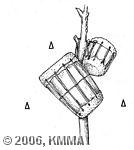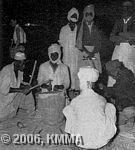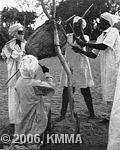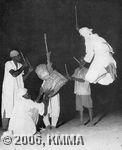






The nanjara and the kwalli are membranophones and differ from each other
only in size. The average size of the nanjara is 39 to 54 cm and the kwalli
ranges from 24 to 35 cm.
The sound box is roughly carved from a piece of tree trunk at the site
where the tree is uprooted. The finer finish is done back in the village. The
sound box is cylindrical in shape but tapers slightly at the bottom, making
the opening at the bottom smaller than the one at the top. Once the carving
is completed, the wood needs to dry. To avoid the wall from cracking, the
sound box is left in the shade during the day time and dug into the ground at
night to keep temperature differences to a minimum. After a few days, liquid
butter is rubbed into the sound box, and after 10 days the wood is
sufficiently dry for the next stage in the process.
The next step is cutting and fitting the membranes, for which only camel
hide is used. The two membranes are attached to each other with thin strips
of camel hide arranged in an H shape around the sound box. Once the membranes
are in place, the hairs are removed from the hide. A small sound hole is also
made in the wood of the sound box with a heated point; this hole is sometimes
referred to as "the eye of the drum".
The nanjara and kwalli drums are played with sticks. These sticks are
cut from young branches of the palm tree or the acacia tree just before
playing begins. The term nanjara is said to stem from the verb nagar, to
speak, and means "he has spoken".
Both drums can be either owned individually or communally. The drums are mostly played together. The nanjara can also be played solo, unlike the kwalli. The reason is that the sound of the kwalli can be reproduced on the nanjara by the smaller membrane at the bottom of the drum. The sound of the nanjara on the other hand cannot be imitated on the kwalli.
The drums are played in different ways. For signalling purposes the drum is played by one man using one single stick. Certain rhythms are played using two sticks and if there is no kwalli drum, then the nanjara can even be played by three drummers, two on the largest membrane and one on the smaller membrane at the bottom to imitate the kwalli.
The drums are usually hung up so that the drummers can be standing as they play. The drummers perform all kinds of movements whilst they play, such as waving their arms, bending their knees, rocking with their bodies, jumping up in the air, and so on. The third drummer, who is often squatting as he plays, is restricted in the way he can move his body but he has more freedom in what he plays. He often adds irregular beats to the more rigid patterns played by the other two players. Well-known rhythms that are often played are digidel and tardena.
The kwalli was used by the war chief to assemble his warriors; he used to sit on his camel as he beat his kwalli drum.
The young men learn to play with a nanjara adaa, a youth nanjara. This is not a membranophone, however, but an idiophone. The young men make a kind of lamellaphone from a piece of palm tree by cutting loose a piece of the bark to make a springy lamella, which is beaten to practice different rhythms.
See also: BRANDILY, M., Instruments de musique et musiciens instrumentistes chez les Teda du Tibesti, RMCA – Human Sciences, Annals Vol. 82, 1974
© KMMA/Monique BRANDILY